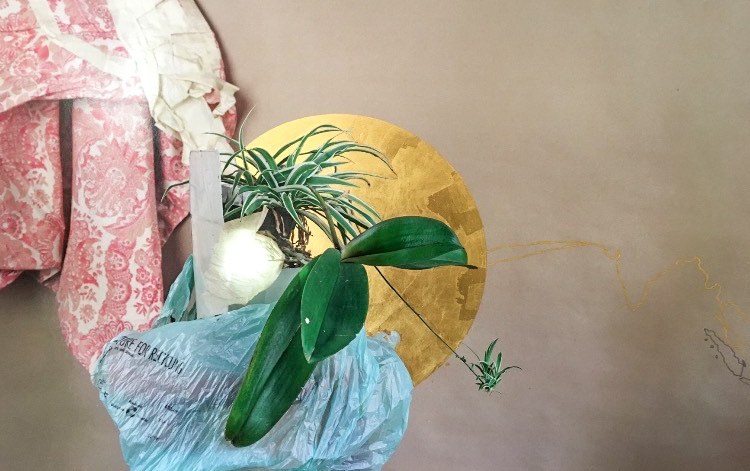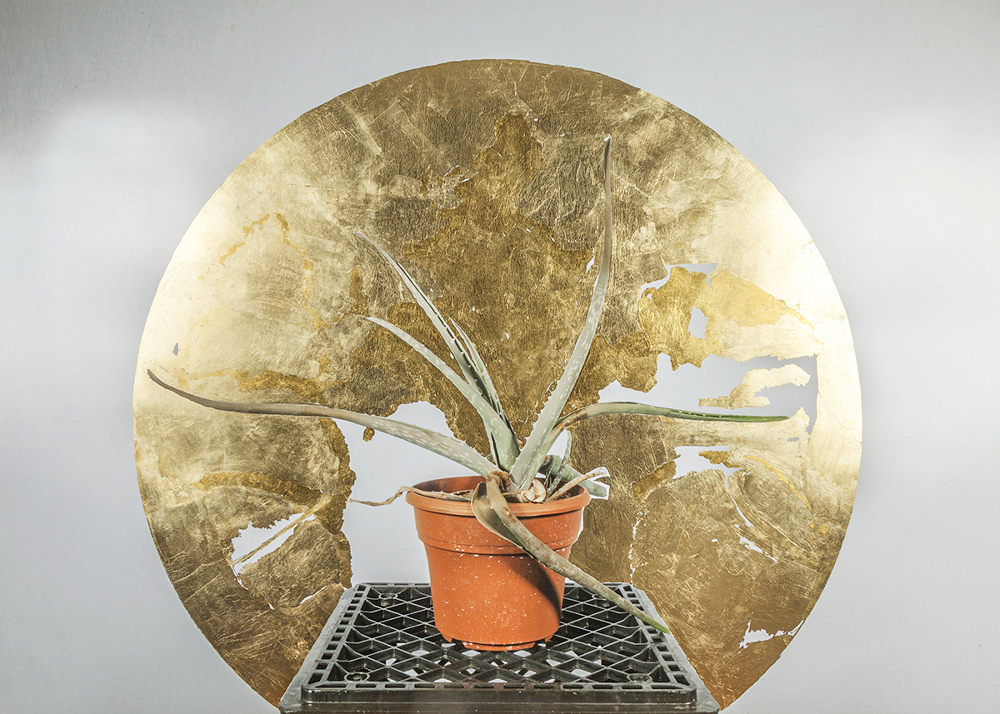
PHOTO: Ruckus
︎ Quappi Projects, Louisville
Photosynthetic Transfigurations
A Work in ProgressFrom elaborate altarpieces that depict saints to gilded Aztec decorations sought by colonizers, the presence of gold in artwork and objects is closely associated with wealth and divinity. How does our perception shift when gold is introduced to that we might define as commonplace? Artist Whit Forrester dramatically reconfigures our relationship to both nature and the ineffable by applying gold leaf to photographs of houseplants. His solo exhibition at Quappi Projects, titled Photosynthetic Transfigurations: A Work in Progress, positions plants as access points to the metaphysical: that which is transcendental or spiritual. The artist contends that we access everything through “metaphorical templates” and utilizes metaphor in his work to link humans and plants with the divine. The brilliant halos that surround these otherwise banal images signify something otherworldly; this surprising juxtaposition allows the viewer to encounter the extraordinary in the mundane and to seek a divine spark inside oneself. Ultimately, Forrester opens a wider conversation regarding the social and economic forces that shape our very perception of nature and spirituality.
Amidst white gallery walls, Forrester’s work has immense presence. His photographs are pinned on the wall and presented plainly; by forgoing frames, the artist gives the viewer unimpeded access to the surface of the work, particularly the hand-applied gold leaf. He immediately challenges the viewer’s expectations through Fig. 6 Tillandsia juncea, Louisville, KY (2015) which is installed in the hallway outside of the gallery. This piece extends outside the borders of the photograph with a large gilded half-circle. The shape creates a fractured halo around the physical image, an extension and repetition of a smaller halo which illuminates an otherwise unextraordinary air plant sitting on a milk crate. Similarly, Untitled (2018) plays with the boundaries of the photograph through elements of installation. Strategically positioned and placed on a Grecian pedestal, broken glass and Chinese herbal medicine appear to spill out of the image itself. Forrester ruptures the borders of these works and places the viewer in even closer contact, further implicating their participation in his overall narrative.
Even his seemingly less elaborate pieces work to advance the series’ concept. Fig. 17 Hedera helix, Chicago, IL (2017) and Fig. 43 Aloe Vera, San Francisco, CA (2016) are intriguing in their imperfection--Forrester applied gold leaf in a manner that suggests these halos were once full, but have worn away over time. Further conveying the notion of the metaphysical existing in otherwise unremarkable scenarios, he includes details such as wrinkled backdrops, brown leaves, and white smudges. By doing so, he provides new ways of comprehending the divine that greatly differ from art historical references. The metaphysical is presented as imperfect and accessible.
Forrester draws upon an extensive lineage of gold leaf and botanical imagery in religious art, but presents radically different ways of thinking about the spiritual. In Christian art of the late Middle Ages, gold leaf was used to denote religious figures and enhance the work’s devotional function. Plants were a common inclusion in Western religious art as well, particularly during the fifteenth and sixteenth centuries. Jennifer Meagher, an expert on Western painting at the Metropolitan Museum of Art, asserts that botanical imagery during this period may suggest the identity of the subject or provide moral or philosophical annotation. While Forrester utilizes a similar metaphorical lens, his end goals are quite different. Ultimately, the artist does not simply position plants as divine; rather, their depiction is a step towards understanding humans’ connection to both nature and the metaphysical. As the exhibition statement asserts, “We are not separate from nature but are undoubtedly part and parcel of its continuum. The mysterious and unknowable divine spark in plants is the same mysterious and unknowable divine spark that exists in us.”
While humans, nature, and the metaphysical are all interconnected, Forrester carefully considers how “histories of colonization and capitalism exist in tandem to our assumed relationships to the natural world, and to what is known as the Divine or spiritual.” Land, and therefore nature, is thought of as a good that can be claimed or owned--this notion manifested most spectacularly and most devastatingly during the Age of Discovery. Europeans became even more wealthy through the exploitation of indigenous peoples in Africa, South America, India, and many other locations. Similarly, Christian missionaries proselytized throughout these “recently discovered” lands and proclaimed their religion as truth. The exhibition statement poignantly elucidates, “In these photographs, gold represents both the literal colonial quest for gold but also the metaphorical desire to represent and connect with the divine and the supernatural. The Conquistadors and the colonizers wanted to become divine, to become light - if only they had known that we are in fact light already, though in a slightly different form.” As global powers consider methods of decolonization, contemporary artists cannot ignore the forces that shaped the world as we know it today. It is refreshing that Forrester fully acknowledges his whiteness and makes efforts to unpack histories of colonialism.
Photosynthetic Transfigurations: A Work in Progress is quite complex and highly conceptual in nature. Viewing the work, however, is a transcendental experience, one that opens the mind to Forrester’s way of thinking. This exhibition presents a unique philosophy and perspective that is both ethical and accessible. To experience such high-caliber conceptual art in Louisville is a delight. Quappi Projects and gallery director John Brooks’s commitment to artistic excellence continues to impress. Both the gallery and Forrester are challenging the status quo in their respective ways - and with spectacular results.
-
Photosynthetic Transfigurations: A Work in Progress is on display at Quappi Projects until February 26.
Quappi Projects is located at 1520b Lytle Street, Louisville, KY 40203 and open by appointment only.
Notes:
Kevin Warth, Contributor to Ruckus
2.22.18
 Fig. 33 Chlorophytum comosum, Louisville, KY (2015). Archival inkjet print with applied gold leaf.
Fig. 33 Chlorophytum comosum, Louisville, KY (2015). Archival inkjet print with applied gold leaf. From East to West: The Extraction and Reproduction of Phaelenopsis and Chlorophytum (2016). Archival inkjet print with applied gold leaf.
From East to West: The Extraction and Reproduction of Phaelenopsis and Chlorophytum (2016). Archival inkjet print with applied gold leaf.
Fig. 43 Aloe Vera, San Francisco, CA (2016). Archival inkjet print with applied gold leaf.

Fig. 6 Tillandsia juncea, Louisville, KY (2015). Archival inkjet print with gold leaf.







